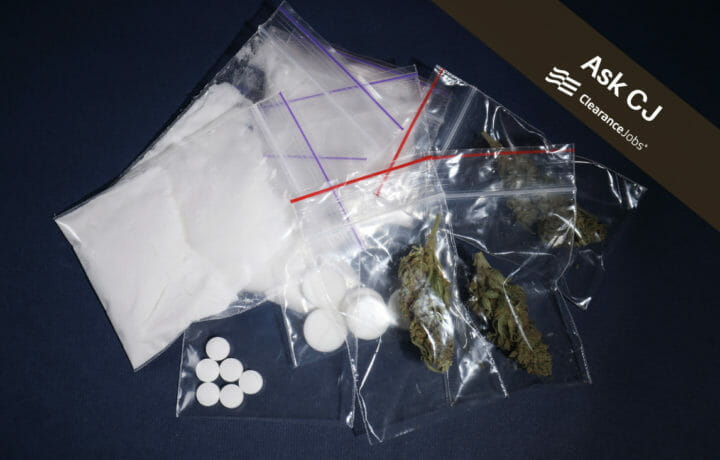Marijuana has been a clearance hot topic over the last decade because there is some gray area between internet rumor, policy, and state drug laws. That’s why it’s always interesting when questions come up relating to use of Schedule I and II drugs – that’s a no-brainer, right?
One ClearanceJobs blog subscriber laid out his rap sheet – not even asking for a friend:
I’m in the process of applying for Federal jobs that require a TS clearance, but I am concerned about being denied. The short of it is, I had a problem, I dealt with the problem, and there is no more problem. However, I also realize that our actions have consequences, so I’m hoping for some guidance from the experts. Details are below along with a few questions.
- What are my chances of being found favorable for a TS clearance?
- Should I volunteer this information even though it’s beyond 7 years? If so, when should I volunteer the information?
- Marijuana – frequently from age 17 to 30 and occasionally from age 30 to 32.
- LSD – approximately one year ending 1995 (estimated)
- Ecstasy – used occasionally for approximate 6 to 12 months ending 1999
- Cocaine – used on and off occasionally for 1 -2 months ending around 2000 with gap until a single use 2008
- Prescription painkillers – used for a week or two at age 32
- Others as a juvenile
Drug distribution – low level but frequent involvement mainly for personal usage, but also for profit. Voluntarily quit in approximately March 2006 with no recurrence.
- Marijuana – age 18 to 30 years with gaps totaling estimated two or three years
- Cocaine – estimated three months approximately 1996-1997
- Hallucinogens – on and off for six to twelve months approximately 1998-1999
Alcoholism – used heavily from age 24 to 32
- Voluntarily entered treatment program on April 21, 2008
- No recurrence of use of alcohol.
Arrests – All charges were related to the drug and alcohol use and were either expunged or received probation before judgement. None remain on my record.
- Possession of paraphernalia – 1994
- Disorderly conduct and trespassing – 1997
- DUI – 2003
Potential mitigating factors –
- Completely sober since 2008
- Excellent Credit
- Recently earned a Bachelor of Science degree – Magna Cum Laude
- Favorably adjudicated at Secret level – 2016
- Has stable job history since 2008
- Few foreign-born contacts
- History has been shared with several hundred people over multiple occasions while giving testimony at church.
DRUG USE ON SF-86
As always, be honest, but answer only the questions required. Because most start with “within the last seven years…” you wouldn’t necessarily be required to answer yes on the SF-86.
In terms of criminal or police records, those questions also have a seven-year timeline, so it wouldn’t require you to document the possession, trespassing, and DUI charges either.
If there are any “have you ever” questions on forms, you must answer them for any amount of time.
MITIGATING FACTORS
Illegal drug involvement can be mitigated if the security clearance applicant is no longer involved with drugs, and it is unlikely they would be involved with them in the future. This subscriber did their homework and were already compiling a list of their personal mitigating factors including being completely sober since 2008 and getting help when they needed it.
On top of the mitigating factors, the applicant relayed that they have maintained excellent credit, recently obtained a bachelor’s degree, has had a stable and positive job history, few foreign-born contacts, and excellent references. They also noted that they were favorably adjudicated at the Secret level in 2016. The ‘additional’ factors won’t help mitigate any drug issues. The specific mitigations for drug use are:
- Which drugs were used.
- Frequency of drug use.
- Recency of drug use.
- Circumstances of drug use.
- Effects of drug use (i.e. mental health, employment, finances, arrests).
The applicant noted his Secret security clearance. It’s worth noting the adjudicative criteria are the same for Secret and Top Secret security clearances – in this case the drug arrests (which are the biggest factor toward clearance denial) should have been addressed during the Secret clearance investigation.
WHOLE PERSON CONCEPT
This candidate is an example of the ‘whole person’ concept and passage of time coming into play. They clearly had some substance abuse issues at a different time in their life but sought out help and were able to obtain security clearance at the Secret level formerly. As long as the applicant was honest in the Secret investigation and doesn’t try to offer forward information that wasn’t previously provided, obtaining a Top Secret security clearance shouldn’t be an issue.
Much about the clearance process resembles the Pirate’s Code: “more what you’d call guidelines than actual rules.” This case-by-case system is meant to consider the whole person, increase process security, and allow the lowest-risk/highest-need candidates to complete the process. This article is intended as general information only and should not be construed as legal advice. Consult an attorney regarding your specific situation.




